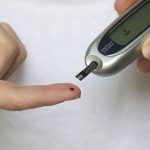
Periodontal disease is very common and over 400 hundred million people worldwide are estimated to be suffering with diabetes and this is expected to rise to over 600 million by 2040. The majority of cases are type 2 diabetes mellitus (T2DM). A number of studies have demonstrated a link between diabetes and periodontal disease.
The aim of this study therefore, was to deter- mine whether baseline periodontitis associated with the subsequent development of T2DM in a cohort of diabetes-free 58–72-year-old men in Northern Ireland.
Methods
Participants were from a longitudinal cohort study of cardiovascular disease in Northern Ireland. Between 1991-4 2748 men were recruited representing around 5% of the 50–60-year-old men in the greater Belfast region. From 2001 to 2003, 2010 surviving men attended for re-screening with their date of attendance taken as the baseline. This study is based on 1400 (69.7%) dentate men who had a comprehensive periodontal examination between 2001-3. Of the remainder, 158 (7.8%) men were edentulous, 363 (18.1%) did not have a dental examination due to the lack of a dental examiner and 89 (4.4%) refused or had a medical condition that precluded periodontal probing. Patients with pre-existing diabetes at baseline were excluded by self-report verified by medical practitioner. Incident T2DM case in the first year were excluded to minimised undiagnosed baseline diabetes.
Parallel to periodontal examination medical, social and demographic information was collected by questionnaire and fasting blood samples were analysed for total cholesterol level and C-reactive protein (CRP). Periodontal examinations were carried out by calibrated dental hygienists.’Severe periodontitis”’required two or more interproximal sites with CAL ≥6 mm, not on the same tooth, and one or more interproximal sites with PPD ≥5 mm. “Moderate periodontitis” was defined as two or more interproximal sites with CAL ≥4 mm, not on the same tooth, or two or more interproximal sites with PPD ≥5 mm, not on the same tooth. For either case definition, at least two teeth must be present.
The men were followed up bi-annually by questionnaire, Medical practitioners were contacted for validation if diabetes diagnosis was reported or medication prescribed. A “time to diagnosis” was generated based on the date the participant was initially examined and their date of diabetes diagnosis.Cox’s proportional hazard models were used to estimate the effect of periodontitis on incident diabetes. Multivariable analysis included adjustment for various known confounders.
Results
- 1331 men were followed up for an average of 7.8 years.
- 80 (6.0%) were diagnosed with T2DM
- 778 men (58.5%) were free from or had mild periodontitis;
- 282 men (21.2%) had moderate periodontitis
- 271 men (20.4%) had severe periodontitis.
- 113 men died
- 7.8% were lost to follow up.
- At baseline men with moderate/severe periodontitis had fewer teeth (p = 0.01), a higher median CRP (p = 0.02), were more likely to have smoking exposure (p < 0.001), a higher prevalence of hypertension (p < 0.05), more likely to be in a lower socio-economic status group (p < 0.01), have less years in education (p < 0.01) and more likely to attend the dentist “only when in trouble” (p < 0.01) than those with no/mild periodontitis.
- The unadjusted hazard ratio (HR) for incident type 2 diabetes in men with moderate/severe periodontitis versus those with mild/no periodontitis was 1.69 (95% CI 1.07– 2.67), p = 0.02. Adjusted hazard models are shown in table below:-
| Hazard ratio (HR) | (95% CI) | |
| Model 1 ; adjusted for age, number of teeth, smoking status and toothbrushing frequency. | 1.69 | (1.06–2.68) |
| Model 2; Model 1+ adjustment for baseline BMI, cholesterol, history of atherosclerotic cardiovascular disease, history of hypertension | 1.70 | (1.07–2.71) |
| Model 3; Model 2+ adjustment for history of education years, dental attendance, marital status and socio-economic status. | 1.68 | (1.06–2.68) |
| Model 4; Model 3+ adjustment for baseline CRP | 1.69 | (1.06–2.69) |
Conclusions
The authors concluded
baseline moderate to severe periodontitis was an independent risk predictor of incident T2DM in a group of 58–72-year-old men in Northern Ireland. This relationship was independent of known confounders for incident T2DM, and could reflect a shared biological pathway between periodontitis and diabetes. Alternatively, periodontal disease may be an aetiological factor for T2DM. Further studies should be aimed at specifically addressing the issue of causality, and the mechanistic process regarding the potential impact of periodontitis on the disease process of diabetes.
Comments
This interesting cohort study provides some indication of an association between moderate to severe periodontitis and developing T2DM. The authors highlight several issues with the study. The lack of baseline fasting glucose to exclude undiagnosed diabetes cases which they have attempted to minimise by excluding case diagnosed in the first 12 months. Periodontal states was only assessed clinically at baseline and while notified and advised to seek treatment it is unknown any interventions were performed. Also while information on a number of potential confounders was collected the possibility of residual confounders or not taking into account other potential confounders should be noted.
Links
Primary paper
Winning L, Patterson CC, Neville CE, Kee F, Linden GJ. Periodontitis and incident type 2 diabetes: a prospective cohort study. J Clin Periodontol. 2016 Dec 30. doi: 10.1111/jcpe.12691. [Epub ahead of print] PubMed PMID: 28036104.
Other references
Dental Elf -11th Nov 2015
Low quality evidence that periodontal treatment improves glycaemic control in diabetics

[…] post Periodontitis and type II diabetes appeared first on National Elf […]
[…] Periodontitis and type II diabetes […]